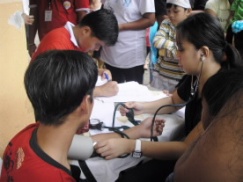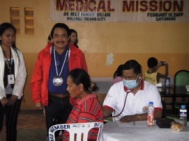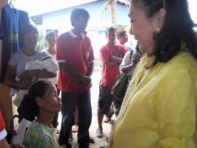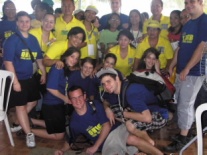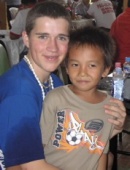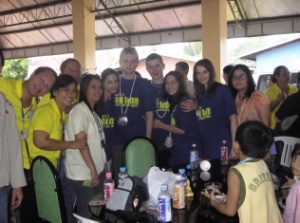-
▼
2009
(132)
-
▼
February
(132)
-
►
Feb 19
(31)
- Captivating Capiz: Dumalag Parish Church
- Captivating Capiz: Gawad Kalinga Medical Mission i...
- Captivating Capiz: Tapaz
- Captivating Capiz: Tapaz Territorial Boundary
- Captivating Capiz: Tapaz History
- Captivating Capiz: Tapaz Official Seal
- Captivating Capiz: Tapaz OFFICIAL FLAG
- Captivating Capiz: Tapaz Motto
- Captivating Capiz: Tapaz Barangays
- Captivating Capiz: Sigma
- Captivating Capiz: Sigma Barangays
- Captivating Capiz: Sapi-an
- Captivating Capiz: Sigma Town Center
- Captivating Capiz: Sapian Barangays
- Captivating Capiz: President Roxas
- Captivating Capiz: President Roxas Barangays
- Captivating Capiz: Pontevedra
- Captivating Capiz: Pontevedra Barangays
- Captivating Capiz: Pilar
- Captivating Capiz: Pilar History and Culture
- Captivating Capiz: Pilar people and Economy
- Captivating Capiz: Pilar Barangays
- Captivating Capiz: Panitan
-
►
Feb 20
(21)
- Captivating Capiz: Panitan Barangays
- Captivating Capiz: Panay
- Captivating Capiz: Panay Barangays
- Captivating Capiz: Mambusao
- Captivating Capiz: Mambusao Barangays
- Captivating Capiz: Ma-ayon
- Captivating Capiz: Ma-ayon Barangays
- Captivating Capiz; Jamindan
- Captivating Capiz: Jamindan Barangays
- Captivating Capiz: Ivisan
- Captivating Capiz: Ivisan Barangays
- Captivating Capiz: Dumarao
- Captivating Capiz: Dumarao Barangays
- Captivating Capiz: Dumalag
- Captivating Capiz: Dumalag Barangays
- Captivating Capiz: Dao
- Captivating Capiz: Dao Barangays
- Captivating Capiz: Cuartero
- Captivating Capiz: Cuartero Barangays
- Captivating Capiz: News update: Ilang kalsada sa C...
- Captivating Capiz: News update: 5 sugatan, kasama ...
-
►
Feb 19
(31)
-
▼
February
(132)
Blog Archive
Recent Viewers
Some resources of our articles!
my SEO!!
my SEO!!
Captivating Capiz - Roxas City Seafood Capital of the Philippines
Captivating Capiz - Roxas City Seafood Capital of the Philippines
Captivate and Experience the Beauty of Capiz
CAPIZ

Seafood Capital of the Philippines
Captivating Capiz: People's Park
Posted by : <-=[]group 3 hooke[]=-> on Sunday, February 22, 2009 | | 0 Comments
Captivating Capiz: Moro Towers
Built in 1814 in order to repel the invading Moors and Portuguese colonizers. These half-torn structures, 7 feet squares, 10 feet high, are vivid souls of the past. Before they were destroyed, they were twice their present height. These towers are made of black pebbles, and are gradually eroding. One tower is on top of the hill at Sitio Nipa, Culasi and the other one is at Brgy. Dumolog.
Posted by : <-=[]group 3 hooke[]=-> on | | 0 Comments
Captivating Capiz: Balay Capiznon
This edifice is the venue where locally made products are displayed. It is located at the foot of the Capiz Bridge and is in the vicinity of the Rizal Monument and the Capiz Provincial Capitol. It occupies 700 square meters of a city government lot.
The initiative to construct this edifice was spearheaded by the city government and the Dept. of Trade and Industry. Construction began in 1997 and was completed in the same year. The Capiz Multi-Purpose Cooperative, Inc., was designated as the caretaker of the place and was tasked to oversee the local products put up for display. Local products like preserved foods and delicacies, handicrafts like shellcraft and furniture made from rail ties can be seen at the place.
In the garden of the venue which occupies almost two thirds of the property, ornamental plants, orchids, fruits tree seedlings and other local plants are housed. This area is also the place where plant exhibits are held several times a year.
The Tourism Promotion and Development Office of the city government moved to this place last December 6, 2003 in order that it could cater more to the needs of the people of Roxas City and the domestic and foreign visitors who continue to frequent the city. The inauguration and blessing of the edifice was graced by Mrs. Judy Araneta Roxas, Senator John Osmeña and Representaive Imee Marcos-Manotoc who came to attend the Sinadya sa Halaran celebrations. The display center was renamed Balay Kapisnon. As expected, the place has become a must see for visitors who come to Roxas City.
Posted by : <-=[]group 3 hooke[]=-> on | | 0 Comments
Captivating Capiz: Roxas City Museum
In 1910, President Pastor Alcazar, third President of the town of Capiz (1908-1912), constructed a water tank near the “Municipio” to provide water to the Kapisnon during the dry months. Water flowed from the roof of the two-storey municipal building to the tank.
The “Municipio” was destroyed during World War II, but the water tank which was 11.5 meters in diameter, 6.10 meters in height and with walls 11 inches thick was spared.
After the war, offices were built around the tank completely hiding it from view with only a water spout visible. In 1993, the offices were demolished and for the first time in three decades, the water tank could be seen. The young people, who were not aware of the existing structure, had to be told that originally, it was a water tank.
The old water tank looks quite imposing, like a lady, grown serene, yet gracious and to demolish it would be like cutting the umbilical cord from the past.
However, that water tank had outlived its usefulness because Roxas City now had a modern water system, a legacy from the late Congressman Gerardo “Dinggoy” Roxas, Jr.
The City Government with a group of culture buffs brain-stormed on what to do with the structure and the idea of converting it to a museum was born. Thus, the Roxas City Museum, Ang Panublion, became a reality with Mrs. Ofelia Rendon as its curator.
Ang Panublion, in its initial exhibit, showcased the Kapisnon: how they lived, how they prayed, how they danced, what they ate, what they wore (gowns, jewelry, etc., and how they spent their time.
Posted by : <-=[]group 3 hooke[]=-> on | | 0 Comments
Captivating Capiz: Pres. Manuel Roxas House
Posted by : <-=[]group 3 hooke[]=-> on | | 0 Comments
Capezeño at Top 10 in 2008 Nursing Board Exam
Ms. Josephine Celoso Elvas, a 21 year old nursing graduate of Filamer Christian College, and Mr. Garry Jay Avelino Delfin of Panitan, Capiz tops the November 2008 Nursing Licensure Examination. Ms. Elvas is the daughter of Constancio Elvas and Juana Celoso of Brgy. Daga, Panay Capiz. While Mr. Delfin is a graduate of Iloilo Doctors College. Both with a rating of 86.80%, Josephine and Garry where ranked as Top 8 on the Nursing Licensure
Examination given last November 29-30, 2008.
Professional Regulatory Commission has announced at least 39,455 or 44.51% out of 88,649 examinees that took the November 2008 Nursing Board have passed. Jovie Ann Alawas Decoyna of Baguio Central University topped the board, with 89 percent.
Josephine took her Bachelor
of Science in Nursing at Filamer Christian College (FCC) in Roxas City last March 2008 where in she had been an Academic Awardee from SY 2004-2006 and Rank 7 out of 370 graduates of the college in SY 2007-2008 . She finished her secondary education at Capiz National High School and her elementary education at Loctugan Elementary School.
vas, her secrets on passing the Nursing Board Exam are composed of 3P’s: Patience, Perseverance and Prayers. With almost 5 months of review and preparation for the Nursing Board Exam at RGO Review Center in FCC, Jos
ephine was able to manage her time, seriously focused on her review and avoid unnecessary activities. With these, prior to the NLE she also top the Pre-Board Exam in Region VI conducted by RGO Review Center to their reviewers. Her advice to nursing graduates who are about to take the exam in order to pass is to be persistent in their study and give honor and glory to God through prayers. She spent 3 hours a day for study/review.
Garry Jay Avelino Delfin is 27 year old, a native of Poblacion, Panitan, Capiz. The son of Eliseo Diestro Delfin and Sylvia Avelino Defin. His grandf
ather is the late Judge Braolio Avelino. He finished his Elementary and Secondary Education at Filamer Christian College (Batch 1998) as an honor student.
Garry enrolled Bachelor of Science in Computer Science at AMA University-Iloilo Branch and graduated last December 2002 as Cum Laude and receive the Student Leadership Award. He worked as a College Instructor for 3 years at his alma mater and then decided to pursue his nursing career by enrolling at Iloilo Doctors College.
He graduated his Bachelor of Science in Nursing at Iloilo Doctors College last April 2008, as Cum Laude. In his review at Merge Review Center (Iloilo Branch), he was recognized as Top 1 in the General Performance and 1st Place in Simulated NLE in the whole Region 6.
Undying love and devotion to his field of choice, total and undivided attention to studies, hard-edged discipline and work ethics; prayers and a strong desire to make his parents and family proud are among his secrets of achieving success in his life.
His aspiration as an educator and professional nurse is to contribute to the improvement of the nursing profession though the education of new and future nurses.
-www.capiznon.wordpress.com
Posted by : <-=[]group 3 hooke[]=-> on | | 0 Comments
Captivating Capiz: Pilar Cave






Posted by : <-=[]group 3 hooke[]=-> on Saturday, February 21, 2009 | | 0 Comments
Captivating Capiz: Quipot Cave
The Quipot Cave is found in Bo, Burias, Mambusao. It is about 3 kms. from the Mambusao Agricultural and Technical College, or 8 kms. from the town proper or a 30-minute ride over rough roads. It is accessible by jeepneys, cars and tricycles. Wild birds, deer and wild duck abound in the place. Near the cave is a stream. The cave consists of many chambers each at a level of different from those of other chambers. In certain sections one has to crawl because the space between the roof and the floor is just two to three feet. There are also sections looking like dead-ends, except for small holes through which only one person can crawl. These holes lead to a chamber as big as a ballroom of a hotel which is why some tourists call it the Quipot Hilton. There are plenty of stalactites and stalagmites. The Quipot Cave is cool inside.
Posted by : <-=[]group 3 hooke[]=-> on | | 0 Comments
Captivating Capiz: Bontod Beach
Bontod Beach. On a bright summer day, Bontod Beach with its fine black sand is a welcome sight. It is 3 kilometers long and is located far from the inhabited section of Pan-ay; hence it is one of the cleanest beaches in Capiz. It is protected on one side by Napti Island and on the other side by the mountains of Pilar. The beach is free of jellyfish all the year round, and its water is cool and clear. It is ideal for swimming and sunbathing. Bontod Beach is 8 km. from the town proper over fairly good roads. It is approximately 10-minute ride by jeepneys, cars and tricycles. It is also accessible by speedboats or pumpboats from any point.

Posted by : <-=[]group 3 hooke[]=-> on | | 0 Comments
Captivating Capiz: Napti Island


-=Napti Island is about three to four hectares big, this island is located near Olotayan Island. It has white sands, a small cave and abundant shells can be found in the area. Napti is uninhabited island. The beach is inviting and the waters are cool and free of troublesome jellyfish the whole year round. A small cave, about 100 meters long, winds several feet below the surface across the island. The island commands a breathtaking view of Roxas City and Pan-ay. Fishing enthusiasts and gourmets have a wonderful time for the plentiful fish and lobster.
-=This small island is near the bigger Olutayan Island. It is a 20-minute ride by pumpboats from Roxas City. It is about three to four hectares in size. The island is rocky on one side and sandy on the other. Napti is not inhabited, hence it is clean. The beach is inviting. The water is cool and clear and free of troublesome jellyfish all the year round. The sand is white and has an abundance of empty shells used in making shell necklaces. A small cave, about 100 meters long, winds several feet below the surface across Napti Island. It has also stalactites and stalagmites. The top of Napti Island is flat and green and is covered with fine swards of grass resembling Bermuda grass. It commands a breath-taking view of Roxas City and Pan-ay. Fishing enthusiasts and gourmets will have a wonderful time here for fish and lobster are plentiful.
Posted by : <-=[]group 3 hooke[]=-> on | | 0 Comments
Captivating Capiz: News update: 5 sugatan, kasama ang 3 Boy Scouts at 1 pulis sa pagsagi ng kani-kanilang sasakyan
ROXAS CITY – Tatlong mga Boy Scouts at isang pulis, kasama na ang isang ina ng Boy Scout ang sugatan sa pagsagi ng patrol car ng Mambusao PNP sa isang pampasaherong jeep kaninang umaga sa Brgy. Ondoy, Ivisan, Capiz.
Sakay ng naturang jeep ang mga Boy Scouts na galing sa Roxas City at papunta sana ng bayan ng Dao para sa taunang Provincial Boy Scout Jamboree,
Napag-alaman na nagsilbing convoy ang nasabing patrol car sa pagbisita ni General Herman Doria hepe ng Police Community Relations, sa lungsod ng Roxas kung saan ito ang naging representante ni PNP chief Director General Jesus Versoza sa isinagawang "Coastal Clean Up drive" ng Roxas City PNP.
Batay sa imbestigasyon, nang-agaw umano ng linya ang minamanehong Toyota Hilux police patrol ni PO3 Gerald Bienes sa lane ng jeep kaya nasagi ang reserbang gulong ng naturang jeep.
Isinugod sa iba't-ibang ospitalsa lungsod ng Roxas ang mga biktima.
Nagtamo ng sugat sa ulo si Don-don Declaro, 12-anyos, Paul Rey Barrientos at Michael Beluso na pawang mag-aaral ng Katipunan Village Elementary School, samantalanfg sugatan naman ang ina ni Beluso na sumamang maghahatid sana sa anak.
Nagtamo naman ng malaking sugat sa baba si PO1 Bonifacio Vergara matapos tumilapon sa kanila ang reserbang gulong na nakalagay sa gilid ng jeep .
Dahil sa pangyayari, ipinagpaliban ng team leader ang pagsali sa camping ng paaralan para bigyang pansin ang pagdebriefing sa mga kabataan na nagkaroon ng trauma sa insidente.
Napag-alaman ng Bombo Radyo Roxas na ang naaksidenteng bagong patrol car ay i-tuturn over pa lamang ngayong araw sa Mambusao PNP .
Subalit dahil sa pagbisita ni Gen. Doria ay hiniram ng 604th Provincial Mobile Group na na-assign sa 1st District ng Capiz ang nasabing patrol car para magsilbing convoy ng heneral.
Posted by : <-=[]group 3 hooke[]=-> on Friday, February 20, 2009 | | 0 Comments
Captivating Capiz: News update: Ilang kalsada sa Capiz, unpassable dahil sa pagbaha
ROXAS CITY - Ilang mga kalsada ang hindi madaanan sa tatlong barangay ng Mambusao, Capiz dahil sa pagbaha dulot ng malakas na pag-ulan.
Ayon kay PO2 Lepaña ng Mambusao PNP, pangunahing nahihirapan sa sitwasyon ang mga motoristang mula sa Brgy. Tumalalud, Tugas at Manibad.
Napag-alaman na malalaking sasakyan lamang ang makadaan at mahirap na para sa mga motorsiklo.
Wala pa namang napapa-ulat na inililikas dahil sa pagbaha.
Pero sa pinaka huling panayan ng isang isatsyon kay Sr. Inspector Igan Vallangan, hepe ng Mambusao PNP, napag-alaman na unti-unti nang humupa ang tubig baha sa nasabing lugar.
Posted by : <-=[]group 3 hooke[]=-> on | | 0 Comments
Captivating Capiz: Cuartero Barangays
Cuartero is politically subdivided into 22 barangays.
|
|
Posted by : <-=[]group 3 hooke[]=-> on | | 0 Comments
Captivating Capiz: Cuartero

Cuartero is a 4th class municipality in the province of Capiz, Philippines. According to the 2000 census, it has a population of 24,286 people in 4,681 households.
Posted by : <-=[]group 3 hooke[]=-> on | | 0 Comments
Captivating Capiz: Dao Barangays
Dao is politically subdivided into 20 barangays.
|
|
Posted by : <-=[]group 3 hooke[]=-> on | | 0 Comments
Captivating Capiz: Dao

Dao is a 4th class municipality in the province of Capiz, Philippines. According to the 2000 census, it has a population of 30,623 people in 5,921 households.
Posted by : <-=[]group 3 hooke[]=-> on | | 0 Comments
Captivating Capiz: Dumalag Barangays
Dumalag is politically subdivided into 19 barangays.
|
|
Posted by : <-=[]group 3 hooke[]=-> on | | 0 Comments
Captivating Capiz: Dumalag

Dumalag is a 4th class municipality in the province of Capiz, Philippines. According to the 2000 census, it has a population of 25,920 people in 5,375 households.
Posted by : <-=[]group 3 hooke[]=-> on | | 0 Comments
Captivating Capiz: Dumarao Barangays
Dumarao is politically subdivided into 33 barangays.
|
|
|
Posted by : <-=[]group 3 hooke[]=-> on | | 0 Comments
Captivating Capiz: Dumarao

Dumarao is a 3rd class municipality in the province of Capiz, Philippines. According to the 2000 census, it has a population of 40,303 people in 7,993 households. It was originally founded in 1580 and officially established by Spaniards under the advocacy of Our Lady of Snows.
Posted by : <-=[]group 3 hooke[]=-> on | | 0 Comments
Captivating Capiz: Ivisan Barangays
Ivisan is politically subdivided into 15 barangays.
- Agmalobo
- Agustin Navarra
- Balaring
- Basiao
- Cabugao
- Cudian
- Ilaya-Ivisan
- Malocloc Norte
- Malocloc Sur
- Matnog
- Mianay
- Ondoy
- Poblacion Norte
- Poblacion Sur
- Santa Cruz
The current mayor is Felipe Yap who won in the last 2007 elections. He is the brother of former Ivisan mayor Noel Yap (who finished all three terms) and the son of former mayor Amelia Yap.
Posted by : <-=[]group 3 hooke[]=-> on | | 0 Comments
Captivating Capiz: Ivisan

Ivisan is a 4th class municipality in the province of Capiz, Philippines. According to the 2000 census, it has a population of 24,256 people in 4,683 households.
Posted by : <-=[]group 3 hooke[]=-> on | | 0 Comments
Captivating Capiz: Jamindan Barangays
Jamindan is politically subdivided into 30 barangays.
|
|
Posted by : <-=[]group 3 hooke[]=-> on | | 0 Comments
Captivating Capiz; Jamindan

Jamindan is a 4th class municipality in the province of Capiz, Philippines. According to the 2000 census, it has a population of 33,966 people in 6,850 households.
Posted by : <-=[]group 3 hooke[]=-> on | | 0 Comments
Captivating Capiz: Ma-ayon Barangays
Ma-ayon is politically subdivided into 32 barangays.
|
|
|
Posted by : <-=[]group 3 hooke[]=-> on | | 0 Comments
Captivating Capiz: Ma-ayon

Ma-ayon is a 4th class municipality in the province of Capiz, Philippines. According to the 2000 census, it has a population of 32,700 people in 6,395 households.
Posted by : <-=[]group 3 hooke[]=-> on | | 0 Comments
Captivating Capiz: Mambusao Barangays
Mambusao is politically subdivided into 26 barangays.
|
|
Posted by : <-=[]group 3 hooke[]=-> on | | 0 Comments
Captivating Capiz: Mambusao
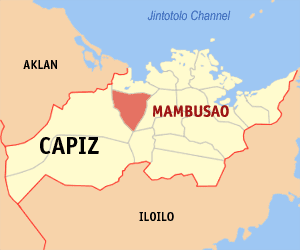
Mambusao is a 4th class municipality in the province of Capiz, Philippines. According to the 2000 census, it has a population of 36,793 people in 7,421 households.
Posted by : <-=[]group 3 hooke[]=-> on | | 0 Comments
Captivating Capiz: Panay Barangays
Panay is politically subdivided into 42 barangays.
|
|
|
Posted by : <-=[]group 3 hooke[]=-> on | | 0 Comments
Captivating Capiz: Panay

Panay or Pan-ay is a 4th class municipality in the province of Capiz, Philippines. According to the 2000 census, it has a population of 40,599 people in 7,660 households. It used to be the Capital of Capiz.
Posted by : <-=[]group 3 hooke[]=-> on | | 0 Comments
Captivating Capiz: Panitan Barangays
Panitan is politically subdivided into 26 barangays.
|
|
Posted by : <-=[]group 3 hooke[]=-> on | | 0 Comments
Captivating Capiz: Panitan

Panitan is a 4th class municipality in the province of Capiz, Philippines. According to the 2000 census, it has a population of 37,458 people in 7,073 households.
Posted by : <-=[]group 3 hooke[]=-> on Thursday, February 19, 2009 | | 0 Comments
Captivating Capiz: Pilar Barangays
Pilar is politically subdivided into 24 barangays.
|
|
Posted by : <-=[]group 3 hooke[]=-> on | | 0 Comments
Captivating Capiz: Pilar people and Economy
Pilar is politically classified as a 4th class economy. Development in basic infrastructure has been stagnant during the last decades. Annual income is low and poverty rates are said to be high, although the town has also seen greater years. The rural municipality is said to be rich in natural resources such as aquatic and mineral wealth. It used to be a very strong seafood producer in the province and once even possessed its own sugar and mining industry.
Major agricultural products of the town include fish, prawn, crab, rice, sugar, cattle and poultry. The town also has its own Baptist Church and Iglesia ni Kristo Parish as wellas its own rural bank along the town market. Dulangan and Casanayan serve as satellite villages of the town.
Most of the town's population are made up by Austronesian descendants, followed by Aetas and a few of Chinese and Spanish ancestry.
Posted by : <-=[]group 3 hooke[]=-> on | | 0 Comments
Captivating Capiz: Pilar History and Culture
The coastal town sprang out from an Austronesian settlement in the early 16th century when indio natives managed to escape colonial tyranny from the Spaniards. The settlement was then known as Sibala, named after the river that ran through the coastal village. In 1570, however, the settlement was seized by Spanish colonial officials and the guardia civil took full control of the village. It later flourished into a bigger and prosperous town and was renamed after its designated patron saint La Nuestra Señora del Pilar ( Our Lady of the Pillar). Several friars and missionaries were assigned to preach in the town since then until it later received its permanent parish priest.
There had been a famous resistance called the Battle of Balisong during the Philippine Revolution in the 19th century as an attempt to overthrow Spanish officials in the municipality led by local revolutionaries Juan Arce and Dalmacio Patricio.
Today, an iconic 12-foot landmark of the Virgin Mary is visible at a mountaintop in Brgy. Dulangan, built by an affluent Chinese-Filipino merchant in honor of the town's patron saint, which is also said to have conducted miraculous powers to its devotees several times.
The town celebrates its annual feast along with the coming of the sacred Santisima Trinidad (The Holy Trinity), an early 18th century wooden figurine from Mexico found by local fishermen in the shores of the town during the British invasion of the Philippines in 1762. The figurine was said to be brought over to the Pacific by a Galleon trading ship from the port of Acapulco, Mexico which was destroyed by British warships during its route in Luzon and was washed off to the coast of Pilar. It is now still visible at the altar of the town's church, the Parish of the Most Holy Trinity.
The town is also known for its rich local heritage in mythology and folklore of legends and supernaturalism. The Legend of the Golden Shiptells the myth of a beautiful fairy that dwells in the caves of the town's mountainous forests and seduces young men every full moon wherein an illusionary lake appears inside the cave of Balisong and the mistress disappears with her victims in a golden ship along with the fading of the lake at sunrise.
Posted by : <-=[]group 3 hooke[]=-> on | | 0 Comments
Captivating Capiz: Pilar

Pilar is a 4th class municipality in the province of Capiz, Philippines. According to the 2000 census, it has a population of 38,903 people in 7,747 households.
Posted by : <-=[]group 3 hooke[]=-> on | | 0 Comments
Captivating Capiz: Pontevedra Barangays
Pontevedra is politically subdivided into 26 barangays.
|
|
Posted by : <-=[]group 3 hooke[]=-> on | | 0 Comments
Captivating Capiz: Pontevedra

Pontevedra is a 3rd class municipality in the province of Capiz, Philippines. According to the 2000 census, it has a population of 40,103 people in 7,673 households.
Posted by : <-=[]group 3 hooke[]=-> on | | 0 Comments
Captivating Capiz: President Roxas Barangays
President Roxas is politically subdivided into 26 barangays.
|
|
Posted by : <-=[]group 3 hooke[]=-> on | | 0 Comments
Captivating Capiz: President Roxas

President Roxas is a 4th class municipality in the province of Capiz, Philippines. According to the 2000 census, it has a population of 27,531 people in 5,119 households. Originally known as Lutod-Lutod, it received its present name after it broke away from the neighboring municipality of Pilar during the booming years of the sugar industry in the 1960's.
Posted by : <-=[]group 3 hooke[]=-> on | | 0 Comments
Captivating Capiz: Sapian Barangays
Sapian is politically subdivided into 10 barangays.
- Agsilab
- Agtatacay Norte
- Agtatacay Sur
- Bilao
- Damayan
- Dapdapan
- Lonoy
- Majanlud
- Maninang
- Poblacion
Posted by : <-=[]group 3 hooke[]=-> on | | 0 Comments
Captivating Capiz: Sigma Town Center
The town center
In the center of town is a well-maintained park known simply as the plaza. It is the venue of many celebrations especially during the town fiesta. People of Sapian show lavish cultural and religious celebrations from July 22 to 26 each year in honour of their patron saint Santa Ana.
Few meters away from the plaza is the municipal hall which holds local government offices. Next to it is the barangay hall and health clinic. Nearby is Sapian Elementary School, two big churches: the Catholic Church and the Aglipayan Church, and the public market.
About one kilometer from the town center is Sapian National High School and Capiz State University (CAPSU) Sapian Branch.
Posted by : <-=[]group 3 hooke[]=-> on | | 0 Comments
Captivating Capiz: Sapi-an
Sapi-an or Sapian is a 4th class municipality in the province of Capiz, Philippines. It belongs to the Second Congressional District of the Province of Capiz. The town's zip code is 5806.
On last count, Sapian has a total population of 25,316 people and 23,854 of the Sapianons are Catholics.
Sapian Bay which is situated in the northern part of the municipality is geographically joined with Capiz Bay. The 30 km² Sapian and Capiz shallow sea bays has extensive intertidal mudflats, sandy beaches, mangrove swamps, estuaries of several small rivers, and associated coastal lagoons and marshes.
Sapian Bay which opens up to the sea is a source of livelihood for many Sapianons. Marine produce from Sapian Bay include green mussels "tahong", oyster "talaba", lobster and different species of fish,and clams. Many lands near sea water were developed into fishponds that produce milkfish (bangus), prawns and crabs.
Another source of livelihood is agriculture. Carpets of rice fields, trees and flowers can be seen as one travels through Sapian along the national road which connect Roxas City to Iloilo and Aklan. The ricefield along the national road are slowly disappearing to give way to housing developments. Sapian's main agricultural produce are rice and coconuts.
Posted by : <-=[]group 3 hooke[]=-> on | | 0 Comments
Captivating Capiz: Sigma Barangays
Sigma is politically subdivided into 21 barangays.
|
|
Posted by : <-=[]group 3 hooke[]=-> on | | 0 Comments
Captivating Capiz: Sigma

Sigma is a 4th class municipality in the province of Capiz, Philippines. According to the 2000 census, it has a population of 27,366 people in 5,541 households.
Posted by : <-=[]group 3 hooke[]=-> on | | 0 Comments
Captivating Capiz: Tapaz Barangays
apaz is politically subdivided into 58 barangays.
|
|
|
Posted by : <-=[]group 3 hooke[]=-> on | | 0 Comments
Captivating Capiz: Tapaz Motto
The Municipal Motto of Tapaz shall be “Regnat Populus Dei” or “The People of God Reigns”. It means that the general welfare of the people (of Tapaz), under the guidance of the Almighty God, reigns supreme and is the guiding principle in public service and in local governance and public service.
Posted by : <-=[]group 3 hooke[]=-> on | | 0 Comments
Captivating Capiz: Tapaz OFFICIAL FLAG
OFFICIAL FLAG
DESCRIPTION AND MEANING OF THE NEW FLAG (Designed by Peter Marlon H. Exmundo with inputs from Mayor Romualdo G. Exmundo, Jr., MD, and Mr. Leorico Fundal of SNNHS)
1. Head of a Deer — The head of the Philippine Spotted Deer, a deer that is endemic in Western Visayas, particularly in the central region of Panay Island (but gradually becoming extinct and given by the DENR a conservation status of IUCN (EN)), with the scientific name of Cervus alfredi, has always been the unique symbol of Tapaz. Symbolizing the once rich fauna and wildlife of Tapaz, it also symbolizes the indigenous people and cultural heritage of Tapaz. The head has eight horns, four on each antler. Two of the horns, one on each antler, are small buds. In Chinese Astrology, the deer, being a swift and agile animal, symbolizes better economic growth and opportunities. The number eight symbolizes continuity and prosperity in the Chinese beliefs. The two small developing horns also symbolize growth. The seasonal shedding and regrowing of the antlers symbolize eternity and constant renewal of the municipality towards progress and development. The deer is facing east where the sun rises 2. Stars — The two groups of twenty-nine six-point gold stars parallel to the top and bottom borders symbolizes excellence and the component barangays of the municipality. The circle of Fifty-eight six-point gold stars along the inner border of the seal symbolizes the component barangays of the municipality. The six-point star is also known as the Star of David and by its Jewish Name, Mogen David (Shield of David). Its use in the flag of the municipality is our affirmation of our Christian faith and heritage, considering that Jesus Christ belongs to the house of King David of Israel. The Star of David is also the symbol Judaism, the elder religious brother of Christianity. 3. Golden Laurel Leaves — Beneath the fifty-eight gold stars are two golden laurel branches and a golden camia flower (family = Zingiberaceae, Scientific Name = Hedychium Philippinese) at the center. The design is similar to the laurel branches and camia flower in the seals of the Mayor and Vice Mayor. They represent the local government of Tapaz as well as the national and provincial government agencies operating in the municipality. 4. Caption — A banner with a yellow background and orange border with the Phrase TAPAZ, CAPIZ using the Bangle font is written on it is placed over the head of deer to let everyone knows that this flag belongs to Tapaz. 5. The Green Background — The background symbolizes the farming community, which is the primary source of livelihood in the municipality.
SIZE RATIO: (A) The length of the width should be twice the length of the height for a width-height ratio of 2:1. (B) For a 2 x 1 meter flag, the height and width of the star is 6 cm x 5.3 cm. The distance from the top and bottom edges of the border is 12 cm.; (C) The height of the head of the deer from the tip of the antler to the base of the neck is 33.55 cm and the width from the tip of the nose to the deep of the left ear is 21.45 cm. (D) The height of the antler from the tip to the base on top of the head is 13.71 cm. (E) The length of the snout from the tip of the nose to the corner of the snout and the neck is 8.71 cm. (F) For the golden branches of laurel leaves, the length is 31.13 cm and the width is 6.75 cm. (G) For the banner above the deer, the width is 5.16 cm, the length excluding the side pennants on which is the captions are placed is 31.97 cm, and the total length is 39.03 cm.
OVERALL MEANING OF THE NEW FLAG
THE FLAG OF THE MUNICIPALITY was redesigned to give it more meaning and reflect the identity of the Tapaznons. With the new flag we discarded the traditional and common method of simply placing the seal of an agency or of a local government unit in the middle of a rectangular cloth, place two holes along the left border, and tussles along the perimeter to make an instant flag. Instead, we only use the relevant symbols and strategically arrange them along the banner
Despite of the suggestion of some persons to discard the head of the Philippine Spotted Deer in the design of the new seal and flag as an obsolete emblem and relic of a bygone era and that a new one reflective of contemporary and future generations should be adopted, we have decided to retain it for the relevance of its meaning to our identity as Tapaznons. Its retention is a sign of our respect, linkage with, and honoring our past, our traditions, and our cultural heritage — it should remind us of the words of our National Hero, Jose Rizal, when he said “Ang Taong Hindi Marunong Lumingon sa Kanyang Pinanggalingan ay Hindi Makakarating sa Kanyang Paroroonan” — and as a reminder to us of our once pristine and lush flora and fauna. However, we accommodated the suggestions of some notable persons to redesign it to make look more like the deer in our hinterlands. Together with the meaning of the symbolism of the deer, by redesigning it and adding other emblems to it to enrich its meaning, we are also signifying our desire for change and to move forward towards progress and development.
The government/public service/sector, the community/barangays and our Christian faith and heritage, and our principal means of livelihood/the private sector, symbolized by the laurel leaves and camia flower, the stars, and the background, respectively refers to us collectively as Tapaznons.
The banner with the caption “Tapaz, Capiz” crowns the flag, because it symbolizes our pride to be part of the Municipality of Tapaz, in the Province of Capiz and to be called Tapaznons and Capiznons.
Posted by : <-=[]group 3 hooke[]=-> on | | 0 Comments
Captivating Capiz: Tapaz Official Seal
OFFICIAL SEAL
OFFICIAL DESCRIPTION AND MEANING OF THE SEAL UNDER MO 16-01 (Designed by Peter Marlon H. Exmundo based on the general specifications of Mayor Romualdo G. Exmundo, Jr., MD, with inputs from Nona G. Vista, Engr. Victorio Jimenez and Ma. Theresa G. Nepomuceno)
1. Mountain Ranges — The two twin-peak mountain ranges symbolizes the hinterlands and tropical forests of Tapaz and the location of Tapaz at the heart or center of Panay Island. 2. River — the River at the center of the two mountain ranges symbolizes the three largest river systems in the Island of Panay that begins in Mt. Nacuron, in Brgy. Hilwan, a hinterland barangay of Tapaz. Panay River, a 152-kilometer long river feeds the 230,587-hectare Panay River System in the Province of Capiz, or almost 88% of the total land area of the province. Aklan River flows to the Province of Aklan and feeds the Aklan River System in the Province. Both rivers share the same stream in Mt. Nacuron. One of the major streams feeding the main stream feeding Jalaur River, which is located in Calinog, Iloilo, is located in Mt. Nacuron. Jalaur River, feeds the Jalaur River System in the Province of Iloilo. 3. Head of a Deer — The head of the Philippine Spotted Deer, a deer that is endemic in Western Visayas, particularly in the central region of Panay Island (but gradually becoming extinct and given by the DENR a conservation status of IUCN (EN)), with the scientific name of Cervus alfredi, has always been the unique symbol of Tapaz. Symbolizing the once rich fauna and wildlife of Tapaz, it also symbolizes the indigenous people and cultural heritage of Tapaz. The head has eight horns, four on each antler. Two of the horns, one on each antler, are small buds. In Chinese Astrology, the deer, being a swift and agile animal, symbolizes better economic growth and opportunities. The number eight symbolizes continuity and prosperity in the Chinese beliefs. The two small developing horns also symbolize growth. The seasonal shedding and regrowing of the antlers symbolize eternity and constant renewal of the municipality towards progress and development. The deer is facing east where the sun rises. 4. Branch of Leaves — The branch of leaves at the left mountain range symbolizes farming, the chief industry and source of income of Tapaz. As a branch of laurel leaves, it also symbolizes the dignified role of the farmers in our country and the excellent contributions of the Tapaznons in national and international development. 5. The Morning Sun — The morning sun, which is placed at the center of the two mountain ranges, as it rises over the east to begin a new day with its seven rays symbolizing hope and faith for a better future. It also symbolizes our unity with our Filipino brothers and sisters, because the morning sun, which is notable in most Asian flags and seals, symbolizes the sun rising from the East. The number seven is also a mystical and lucky number in most cultures and beliefs. For the Jews, the number seven is the symbol of perfection, thus we have the seven cardinal virtues, the seven beatitudes and the seven habits of highly successful people. Its seven rays symbolize the seven cardinal virtues, and the seven beatitudes 6. The Bird — the bird, specifically the dove, traditionally symbolizes The Holy Spirit. Love and bravery are traditionally symbolized by the color red. The red silhouette of the bird flying in the center of the morning sun symbolizes the spirit of bravery, peace and love living in every soul of each Tapaznon, nourished by the Holy Spirit. However, in the seal the bird is not just a dove but also a parrot or tikoy the official bird of the municipality (which is found in the hinterland of Tapaz and whose number is fast depleting). Its common name in English is “Blue Nape Parrot” and its scientific name is “Tanygnathus luzonensis”. It is placed in the center of the sun and the mountain peaks as a symbol of our unity as Tapaznons under the inspiration and guidance of the Holy Spirit. The bird is facing east where the sun rises. 7. The Blue Background — The background, which is sky blue, symbolizes the clear sky over Tapaz. The color sky blue is usually attributed to the Blessed Virgin Mary, the mother of Jesus, and as the color of the Immaculate Conception, the Patroness of the Province of Capiz. 8. Stars — The circle of Fifty-eight six-point gold stars along the inner border of the seal symbolizes the component barangays of the municipality. The six-point star is also known as the Star of David and by its Jewish Name, Mogen David (Shield of David). Its use in the seal of the municipality is our affirmation of our Christian faith and heritage, considering that Jesus Christ belongs to the house of King David of Israel. The Star of David is also the symbol Judaism, the elder religious brother of Christianity. 9. Captions — The seal is surrounded by the following captions: “SAGISAG NG MUNISIPYO NG TAPAZ” (color blue using Bangle as font) and “LALAWIGAN NG CAPIZ” (color red, using Bangle as font). The use of Tagalog or Filipino in the captions symbolizes the unity of the Tapaznons with the Filipino people. The blue and red colors of the captions are the two main colors of the Philippine flag and seal. 10. Numbers — Dividing the two captions are the numbers “1874” and “2005” in gold or yellow orange color. 1874 was the year Tapaz was separated from Dumalag with the appointment of Don Pedro Gimeno as our first local chief executive, which is called at that time as Capitan Mayor, and Padre Jose Aparicio as our first parish priest; and 2005 was the year the new seal was adopted.
OVERALL MEANING OF THE NEW SEAL
THE SEAL OF THE MUNICIPALITY was redesigned to give it more meaning and reflect the identity of the Tapaznons. With the new Seal we added new symbols and arrange them accordingly along the seal as described above to reflect the true identity of the Tapaznons. Despite of the suggestion of some persons to discard the head of the Philippine Spotted Deer in the design of the new seal and flag as an obsolete emblem and relic of a bygone era and that a new one reflective of contemporary and future generations should be adopted, we have decided to retain it for the relevance of its meaning to our identity as Tapaznons. Its retention, together with the number “1874”, the year Tapaz was separated from Dumalag, are signs of our respect, linkage with, and honoring our past, our traditions, and our cultural heritage — it should remind us of the words of our National Hero, Jose Rizal, when he said “Ang Taong Hindi Marunong Lumingon sa Kanyang Pinanggalingan ay Hindi Makakarating sa Kanyang Paroroonan” — and as a reminder to us of our once pristine and lush flora and fauna. However, we accommodated the suggestions of some notable persons to redesign it to make it look more like the deer in our hinterlands. Together with the meaning of the symbolism of the deer, by redesigning it and the number “2005”, the year the new seal was adopted, we are also signifying our desire for change and to move forward towards progress and development. The community/barangays and our Christian faith and heritage, our location in the middle of the Island of Panay, the clear blue skies above us, our principal means of livelihood/the private sector, and our values symbolized by the stars, the twin mountain ranges and the river, the blue background, the branch of laurel leaves, and rays of the sun and the red silhouette of the bird respectively refers to us collectively as Tapaznons. The captions and their blue and red colors is our affirmation of our love for our municipality, province and country and our pride to be part of the Municipality of Tapaz, in the Province of Capiz, of the Republic of the Philippines, and to be called Tapaznons, Capiznons, and Filipinos.
ADDITIONAL AND UNOFFICIAL (NOT PART OF MO 16-01) MEANING OF THE SEAL
MYSTICAL MEANING OF THE NEW SEAL
IF YOU WILL EXAMINE CLOSELY THE SEAL you will find new symbols and meaning to the seal. These symbols were just discovered later, some of then after the Seal was already presented to the public and was in general use by the municipal government and some agencies within the municipality and some a few weeks after the enactment of the Proactive Administrative of Code under Municipal Ordinance No. 16-01 on 14 September 2005. The six-point star or hexagram was placed there for its originality to give Tapaz a star different from the rest. It should be noted that most are using the five-point star or the pentagram in their symbols. About two weeks before the enactment of MO 16-01, the author realized that the hexagram is the Star or Shield of David. Sometime in November 2005, it came to the knowledge of the author that the hexagram is the Jewish equivalent of the Chinese (originally Taoist) “Yin and Yang”, the symbol of universal and cosmic harmony and balance. By surrounding the seal, they provide harmony and balance in municipality. The hexagram is the unity of the pyramid, symbolizing the male or the positive force or energy of nature and the vessel (the reverse pyramid), symbolizing female or negative the negative force or energy of nature. The positive and negative energies balance each other thus providing harmony in nature and in the universe. The twin mountain peaks, shaped like pyramids and the v-shaped valley in between them are symbols of the “Yin and Yang”, though they are placed side by side instead of overlapping. From the valley (the vessel) contains the rising sun with its seven (the mythical perfect number) rays as it reinvigorates, renews, and brings us hope and faith for a better future with the red silhouette of the bird of peace and love. These virtues become the source of life, strength and nourishment as they flow from the vessel symbolized by the river (water) flowing from the base of the valley and continuously refreshed by the loving guidance and intercession of the Blessed Virgin Mary, the mother of Jesus, and as the color of the Immaculate Conception, the Patroness of the Province and Archdiocese of Capiz, as symbolized by the blue sky. The meaning of the deer and the branch of leaves completes the mysticism of the meaning of the seal. These symbolisms can also be interpreted in a Christian perspective. The mountains and the sky symbolize our unity with Christ, our Savior and our Creator. This unity is manifested by the Divine graces, virtues, and blessings (the sun and the bird) contained in the vessel or chalice (the valley), which eternally (represented by the seven rays of the sun) flow out (represented by the river) to us to cleanse, nourish, and reinvigorate us, wherever we are (represented by the 58 stars symbolizing the 58 barangays) and whoever we are (represented by the deer, symbolizing the indigenous people). The symbolism of the deer is unintentionally similar to the “Moor of Freising” in the Coat of Arms of Pope Benedict XVI. Together with our reverence and care with His creation (represented by the color green and the branch of laurel leaves, which also symbolizes excellence and the greatness of these graces and unity), by being united with Christ and sharing in His perfect (represented by the number seven) and unlimited love in unity with Mary, His Blessed Mother (represented by the color blue of the sky), our unity with our Filipino (represented by the Captions and the colors blue and red) and Asian (the sun rising from the east) brothers and sisters, and our reverence to our ancestors and pride of our historical heritage (both represented by the number 1874), and our concern for the welfare of the future generations (represented by the number 2005 and the antlers of the deer) universal harmony (symbolized by the hexagram) reigns.
Posted by : <-=[]group 3 hooke[]=-> on | | 0 Comments
Captivating Capiz: Tapaz History
Tapaz was founded in 1835 but it continued being a part of Dumalag for many years. In 1862 and 1863 two letters were made to declare parish under the patronage of St. Jerome. Both were signed by Governor General Lemery, but they were never executed. Finally, in 1874, Tapaz was declared an independent parish by Jaro Bishop Mariano Cuartero.
Posted by : <-=[]group 3 hooke[]=-> on | | 0 Comments
Captivating Capiz: Tapaz Territorial Boundary
a. Location — Tapaz lies within the latitude 11º 09’ to 11º 09’ 42” and the longitude of 121º 11’ to 122º 34’ 45”. b. Basic Description It is bounded on the northwest and northeast by the Municipality of Jamindan in the Province of Capiz, on the north by the Municipality of Libacao of the Province of Aklan, on the east by the Municipality of Dumalag of the Province of Capiz, on the west by the Province of Antique, and by the Province of Iloilo, principally by the Municipalities of Janiuay, Lambunao, Calinog and Bingawan from the Southwest to the Southeast.
Posted by : <-=[]group 3 hooke[]=-> on | | 0 Comments
Captivating Capiz: Tapaz

Tapaz is a 3rd class municipality in the province of Capiz, Philippines. According to the 2000 census, it has a population of 44,085 people in 8,739 households.

Posted by : <-=[]group 3 hooke[]=-> on | | 0 Comments
Captivating Capiz: Gawad Kalinga Medical Mission in Capiz with the Seebach Jubla
The Gawad Kalinga (GK) Medical Mission was held at the Holy Family GK Village (HFGKV) in Milibili, Roxas City last
February 14, 2009. It was supported by the Capiz Provincial Government. The medical mission’s purpose was to look out and take good care of all Capizeños for a better health.
It started with an invocation led by Mr. Rito Victoriano, the GK Management Board (GKMB) – Values Formation Head and a welcome message from Mr. Roy Donato, the Couples for Christ (CFC) Provincial Area Director. Mr. Mert Rosano, the GK Provincial Coordinator, reported updates about the HFGKV. He said that the last medical mission was held in 1996. Governor Victor A. Tanco, Sr. and Mayor Vicente B. Bermejo were also present. Mrs. Judy A. Roxas came in behalf of Senator Mar Roxas who donated 4 houses for the GK.
The participants were the GK Caretaker team, the Capiz Visitors and Convention Bureau (CVCB) and 16 Swiss nationals of the Seebach Jubla - a youth association based in Switzerland. They wanted to see for themselves the 46 houses that they have donated. There were 4 houses left for them to paint. Mr. Alex Gonzales, a deacon of Ma. Lourdes Parish in Zurich, Switzerland, facilitated donations from them.
Free medical check-up was conducted among 515 patients of all ages by Dr. Ramon Nolasco, Dr. Hector Flores, Dr. Jonacel Arceño and Dr. Donalyn Bonites. Food was distributed to the volunteers and medicine for the patients. The volunteers came from different sectors of the community. GK t-shirts were sold for P100 to support the organization.
The medical mission lasted the whole morning and was a success even it was raining. Milibili was located outside Roxas City and it was an unforgettable experience especially for the 16 Swiss nationals. Only a few of them knows how to speak in English but they enjoyed painting the houses.
The best part was that the poor have received health benefits during Valentines Day. There were a total of 60 houses built and through the Gawad Kalinga, the poor have felt love that will motivate them to live with integrity.
Author - Sheilla May O. Baes
Posted by : <-=[]group 3 hooke[]=-> on | | 0 Comments
Captivating Capiz: Dumalag Parish Church
Dumalag Parish Church
Another tourist attraction in Dumalag is the Dumalag Parish Church under the Patron St. of Saint Martin de Tours. The first church and convent of Dumalag were constructed between 1600 and 1720, and the parish was dedicated to Saint Martin of Tour, a bishop. In 1833 Fr. Augustin Duran, whose name has been adopted by one of the Dumalag’s biggest Barangays, started the construction of present church. The church had a five story bell tower which rose majestically at the left side of the church.
The church made of yellow sandstone, is 70m and 18m wide. It has two doors at the side and one in the front. Small pilasters decorate the facade wall. Six engaged rectangular pilaster rise up to the triangular pediment. The five story bell tower rises gracefully by the left side of the church.
Posted by : <-=[]group 3 hooke[]=-> on | | 0 Comments















